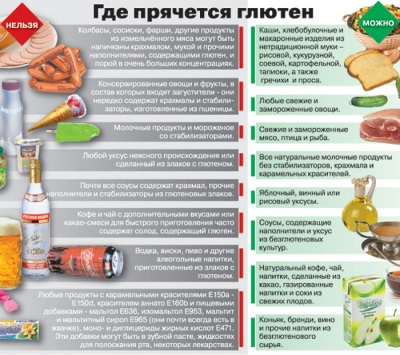Symptoms of celiac disease in children and features of the disease
Many people have heard about gluten these days, and its presence is noted on food labels. Such marks are very important for patients with celiac disease. What is this disease, how is it related to gluten and how does this pathology occur in childhood?
What is it?
The disease is hereditary, because the predisposition to it is transmitted to children from their parents. Pathology is associated with protein intake. gluten in baby food and other products. They are rich in cereals such as wheat, barley and rye. When this protein enters the intestines of a child with celiac disease, the immune system in his body attacks the intestinal cells. The result will be an inflammatory process. To activate it, a child only needs to eat a meager amount of gluten.
Previously it was believed that this pathology necessarily manifests itself in childhood, so the presence of symptoms of celiac disease in adults was not associated with this diagnosis. Now doctors agree that often the disease is hidden and its clinical symptoms may occur in adolescence or adulthood.
Symptoms
The first signs of the disease appear in children during the introduction of gluten into their diet. Among them:
- Prolonged diarrhea, in which the stool is watery, in large quantities and with an unpleasant odor.
- Insufficient weight gain (the child may even lose weight).
- Refusal to eat.
- Bloating.
- Attacks of vomiting.
- The child may be drowsy or lethargic, as well as tearful, irritable.
If the pathology is not diagnosed before the age of two years, the child may begin to lag behind in physical development, his diarrhea begins to alternate with constipation, and rickets often develops. Children older than 3 years often complain of sudden nausea, as well as abdominal pain.
Complications and consequences
Since a child with celiac disease is often not diagnosed immediately, the inflammatory process in the intestine becomes chronic, which impairs its function. Nutrients that enter the body of a baby with food are poorly absorbed, which can disrupt the functioning of any organ. Not detected at an early age, the disease leads to a delay in physical development.
In adolescents, celiac disease can manifest as short stature, anemia, delayed puberty, skin rashes that look like itchy spots or blisters. Lack of nutrients can result in the destruction of tooth enamel, osteoporosis, neuropathy, arthritis, depression and many other problems.
If the disease began in a child under two years old and develops rapidly, there is a risk of death.
What to do?
If a family member and a doctor suspect celiac disease in a child, it is important to conduct an examination and confirm the diagnosis, and then prescribe a special diet for the baby, which will help to completely get rid of all the symptoms of indisposition.
Diagnostics
A doctor may suspect celiac disease by characteristic clinical manifestations and the presence of patients in the family. After inspection and general research methods (blood test, coprogram) appoint a special examination.
Immunological
These analyzes help determine if the child has antibodies that began to be produced when cells of its immune system were in contact with gluten. For tests, blood is taken from a vein.If the results are positive, they indicate that the child may have celiac disease, but cannot precisely confirm the disease, therefore, after immunological tests, a biopsy is often prescribed.
Biopsy
With the help of a biopsy, you can make a final diagnosis. Since the procedure is rather complicated, it is prescribed only after other examinations with high probability of celiac disease. To obtain intestinal tissue, perform fibrogastroduodenoscopy. If a patient has dermatitis, then you can also take a skin tissue for a biopsy (there are deposits of antibodies in celiac disease).
Treatment
The most effective way to eliminate the symptoms of celiac disease is the elimination of gluten from the diet. If the child begins to follow a special diet, it will be completely healthy, because the intestines that are not in contact with gluten will not become inflamed.
Starting to follow a diet, most patients note a significant improvement in health in the first week, but it takes from 6 months to 2 years to completely get rid of the symptoms.
Dieting may not help only in cases where the disease is detected late, and the intestinal tissue is severely damaged. Such patients are prescribed hormonal drugs and other treatment.
Nutrition
Since inflammation of the intestinal tissue in celiac disease can provoke a very small amount of gluten (literally a few bread crumbs), this protein will have to be excluded from the diet completely. It is found in cereals such as wheat and rye, as well as barley. Dishes in which these cereals are present should be excluded from the child’s diet.
To be sure that there is no gluten in the child’s food, it is necessary to cook for the baby at home. Wheat flour can be replaced with corn, buckwheat, almond, rice, sorghum flour, chickpea flour, as well as corn or potato starch. You should also make sure that gluten-free foods are stored separately from baby food. Read the product labels carefully, as most products now indicate whether they contain gluten.
Also, patients with celiac disease may be contraindicated in some medications to which gluten is added.
Probability of transmission by inheritance
The presence of celiac disease in parents does not mean that the disease will be transmitted to children, because the genes responsible for the susceptibility to this disease may be absent in the child. In addition, even with the transfer of the gene to children, the disease does not necessarily manifest itself. To find out how high the risk of inheriting the disease from a particular child, you need to be screened.
Studies have confirmed that the risk of celiac disease in babies who have a predisposition to the disease is affected by the type of feeding. If in the first months of life the baby receives only breast milk, and in the period when products with gluten begin to appear in the baby’s diet, breast-feeding continues, the risks of developing pathology are reduced.
It is also noted that intestinal infections, including rotavirus infection, contribute to the development of the disease. Therefore, if a child has a genetic predisposition, it is important to conduct a cycle of vaccinations against this pathogen.














